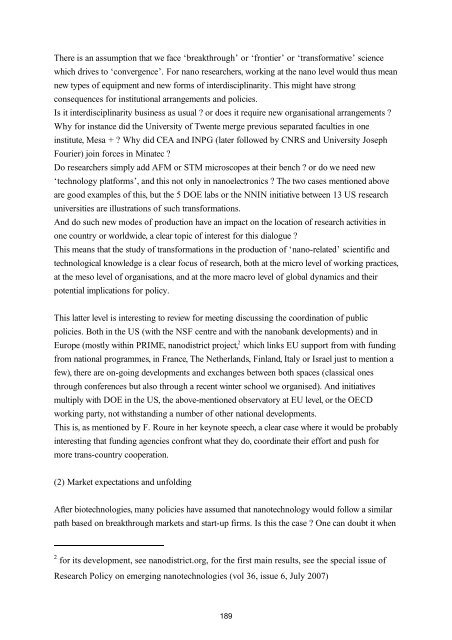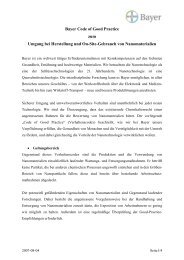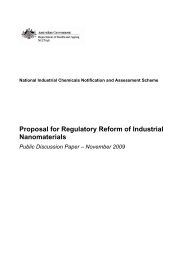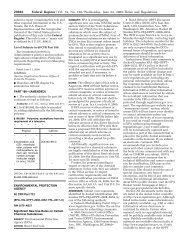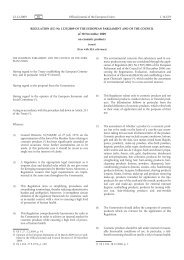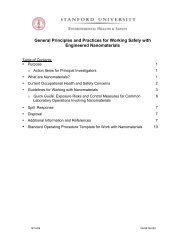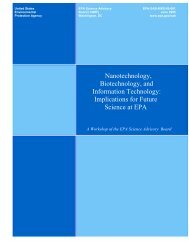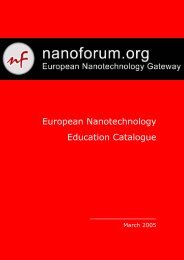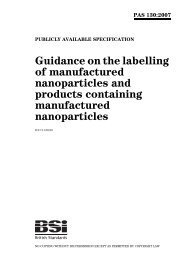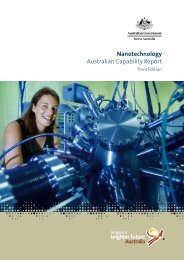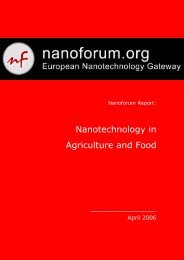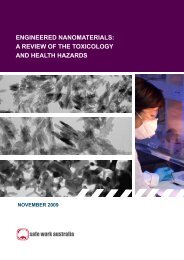Nanotechnology - Nanotech Regulatory Document Archive - Arizona ...
Nanotechnology - Nanotech Regulatory Document Archive - Arizona ...
Nanotechnology - Nanotech Regulatory Document Archive - Arizona ...
You also want an ePaper? Increase the reach of your titles
YUMPU automatically turns print PDFs into web optimized ePapers that Google loves.
There is an assumption that we face ‘breakthrough’ or ‘frontier’ or ‘transformative’ science<br />
which drives to ‘convergence’. For nano researchers, working at the nano level would thus mean<br />
new types of equipment and new forms of interdisciplinarity. This might have strong<br />
consequences for institutional arrangements and policies.<br />
Is it interdisciplinarity business as usual ? or does it require new organisational arrangements ?<br />
Why for instance did the University of Twente merge previous separated faculties in one<br />
institute, Mesa + ? Why did CEA and INPG (later followed by CNRS and University Joseph<br />
Fourier) join forces in Minatec ?<br />
Do researchers simply add AFM or STM microscopes at their bench ? or do we need new<br />
‘technology platforms’, and this not only in nanoelectronics ? The two cases mentioned above<br />
are good examples of this, but the 5 DOE labs or the NNIN initiative between 13 US research<br />
universities are illustrations of such transformations.<br />
And do such new modes of production have an impact on the location of research activities in<br />
one country or worldwide, a clear topic of interest for this dialogue ?<br />
This means that the study of transformations in the production of ‘nano-related’ scientific and<br />
technological knowledge is a clear focus of research, both at the micro level of working practices,<br />
at the meso level of organisations, and at the more macro level of global dynamics and their<br />
potential implications for policy.<br />
This latter level is interesting to review for meeting discussing the coordination of public<br />
policies. Both in the US (with the NSF centre and with the nanobank developments) and in<br />
Europe (mostly within PRIME, nanodistrict project, 2 which links EU support from with funding<br />
from national programmes, in France, The Netherlands, Finland, Italy or Israel just to mention a<br />
few), there are on-going developments and exchanges between both spaces (classical ones<br />
through conferences but also through a recent winter school we organised). And initiatives<br />
multiply with DOE in the US, the above-mentioned observatory at EU level, or the OECD<br />
working party, not withstanding a number of other national developments.<br />
This is, as mentioned by F. Roure in her keynote speech, a clear case where it would be probably<br />
interesting that funding agencies confront what they do, coordinate their effort and push for<br />
more trans-country cooperation.<br />
(2) Market expectations and unfolding<br />
After biotechnologies, many policies have assumed that nanotechnology would follow a similar<br />
path based on breakthrough markets and start-up firms. Is this the case ? One can doubt it when<br />
2 for its development, see nanodistrict.org, for the first main results, see the special issue of<br />
Research Policy on emerging nanotechnologies (vol 36, issue 6, July 2007)<br />
189


